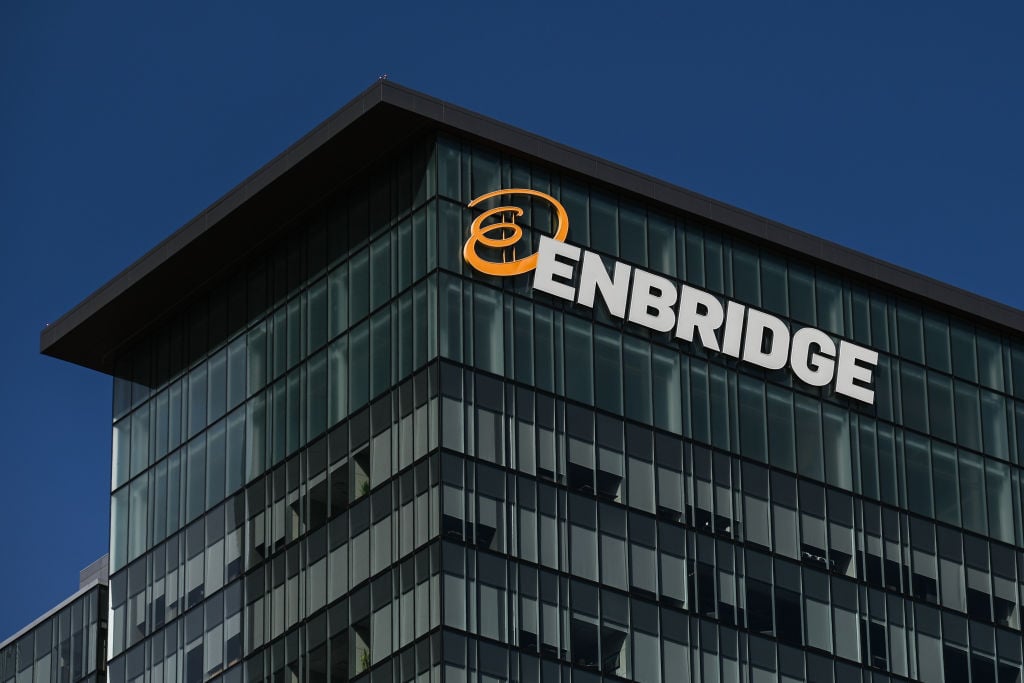Canada's Enbridge (ENB 0.23%) has had a pretty rough year so far. Shares are down roughly 20% since the start of the year, and nearly 30% from early-year highs. A lot of that pain has come from the downbeat view investors have of the energy sector, but negative press surrounding the company's Line 5 pipeline hasn't helped either. Is this decline an opportunity for long-term investors, or a warning sign to stay away?
1. Oil is a problem, but how big?
The global efforts to slow the spread of COVID-19, which have basically involved countries shutting their economies, materially reduced demand for oil and natural gas. The supply/demand imbalance got so bad that, for a brief moment, oil prices fell below zero. That effectively meant that oil companies were paying customers to take oil. Just about anything tied to oil and natural gas have been hit, Enbridge included.

Image source: Getty Images
This is a real problem, but perhaps not in the way investors think. The majority of the company's midstream business is fee-based, meaning it gets paid for the use of its assets -- the price of what's flowing through the system isn't all that important. However, if demand for oil and natural gas were to start declining, it would likely mean less demand for the company's assets. And that could result in fewer long-term growth opportunities, since new assets wouldn't be needed.
That said, Enbridge believes the demand decline in its core North American markets will be temporary and largely reversed by the end of the year. So perhaps this isn't as big an issue as some appear to fear today. Only time will tell which way things go, of course, but Enbridge clearly believes the energy industry offers plenty of opportunity.
2. Spreading its bets
Another interesting thing about Enbridge is that it has a fairly diverse portfolio, with oil-focused pipelines (55% of EBITDA), natural gas pipelines (27%), natural gas utility assets (13%), and a small renewable power business (4%). Its assets span across North America and help to move, according to the company, 25% of the region's crude oil and 20% of the natural gas consumed in the United States. Its utility operations, meanwhile, serve 3.8 million customers. Although some of its pipelines are large and material to its overall revenue, and oil is clearly the most important product it moves, Enbridge has a fairly balanced business overall. That gives it multiple sources of revenue and multiple avenues for growth.
3. The Line 5 issue
With that background, the recent shutdown of Line 5 over environmental concerns is worrisome. Essentially, there was an incident that weakened a support for an underwater pipeline, and a judge ordered the pipeline shut until the safety of the asset could be verified. The biggest takeaway here is that environmental issues are increasingly important, a fact on clear display when a judge ordered the Dakota Access pipeline, operated by Energy Transfer, to shut down (Enbridge owns a piece of it).
However, as Motley Fool's Matthew DiLallo noted, Line 5 only accounts for 2% of Enbridge's earnings. In a worst-case scenario, bottlenecks caused by the shutdown could impact 5% of earnings. But even those fears may be overblown, with the pipeline already starting the reopening process. Moreover, oil and natural gas are still vital fuels, and will remain so for many years. Shutting pipelines down isn't a long-term solution to environmental issues because it simply creates other issues, notably including supply constraints in key population regions. Environmental issues need to be monitored, but the need for energy is likely to win the day... at least for now.
ENB Financial Debt to EBITDA (TTM) data by YCharts
4. Solid-ish foundation
The last issue to consider here is Enbridge's balance sheet. The company has a debt to equity ratio of roughly 1 times, which is in line with that of peer Kinder Morgan and well below that of ONEOK, which sits at around 2.5 times. That said, financial debt to EBITDA is at the high end of the industry, with Enbridge coming in at roughly 7 times while more conservative peers are in the 3-to-4-times range. However, Enbridge isn't out of line with Kinder or ONEOK, both of which are structured as traditional companies, not master-limited partnerships (an arguably more complex financial structure often used in the midstream space). And, notably, Enbridge has long made heavy use of leverage without major incident. Specifically, it has increased its dividend annually for more than two decades. While it wouldn't be correct to say Enbridge has the cleanest balance sheet in the midstream industry, it has proven over time that it can handle leverage in a consistent and reliable fashion while still rewarding investors very well along the way.
Probably worth a look
Enbridge is facing headwinds today, there's no doubt about that. However, the size and scope of the issues are, perhaps, not as big as investors fear when you look at the overall company and the global energy picture. With a roughly-7.5% dividend yield, long-term investors who can handle some uncertainty should be willing to do a deep dive here. The risk/reward balance looks like it's tilted toward the reward side of the scale.







